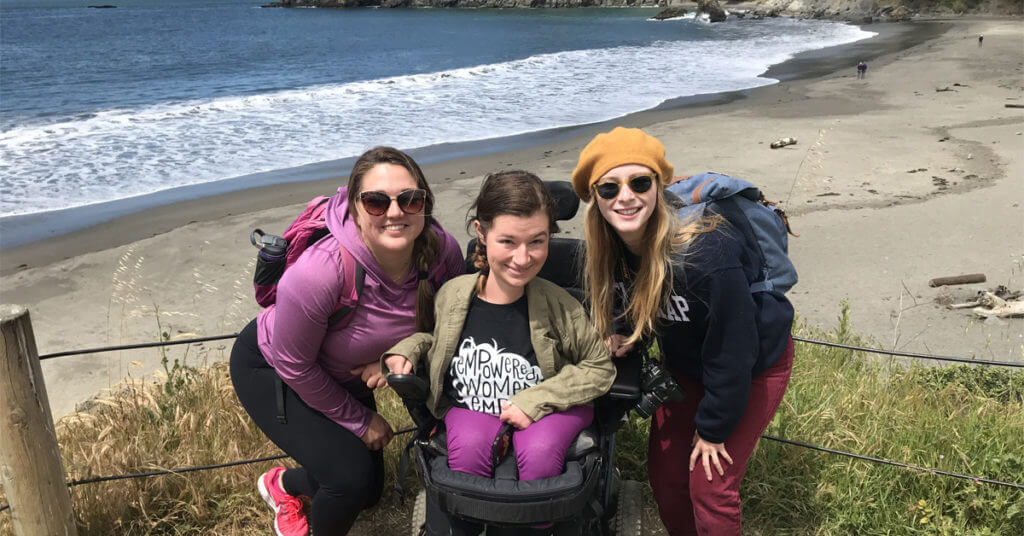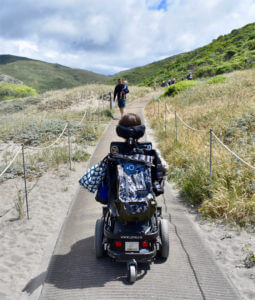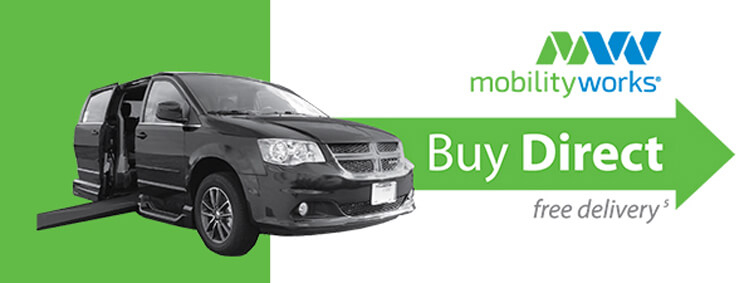
Last month, our friend Hannah Soyer traveled to San Francisco to explore the Bay Area. Hannah is an activist for the community, published author, and Ms. Wheelchair Iowa 2017. You can read about her adventure below, and receive 10% off accessible rentals from MobilityWorks Burlingame, Oakland and San Jose locations, for the entire month of June.
San Francisco on Wheels
By: Hannah Soyer
San Francisco is known for, among many things, it’s impressive hills. San Francisco doesn’t seem to know the meaning of the word “flat”, especially the famous portion of Lombard Street that has eight sharp turns, earning it the title of the most crooked street in the world.
San Francisco also is home to cable cars, but anyone with mobility issues should know that none of the cable car lines are wheelchair accessible. While there are other public transportation options, such as trains and buses, I knew from traveling to other big cities that public transportation can be a hassle, especially if you’re new there and haven’t had time to figure out how everything works. I also knew that if you’re relying on public transportation to get places, you’re also dependent on their timetables, and there isn’t a lot of wiggle room.
Like any new place, there’s always many different neighborhoods, eateries, and sites to explore. I took a weeklong trip to this city recently with my cousin and friend, and as I had never been there before and like to experience as much as possible. It was good, that we had reserved a wheelchair accessible rental van through MobilityWorks so that we could easily get from one place to the next.
The other important thing to keep in mind with public transportation is that busses and trains do not take you directly to where you need to go – you’ll need to walk from or to a bus or train stop, and I quickly realized once we got to the city that this would have been tricky to swing, due to all those hills!
Renting the vehicle
I had never rented before, so I didn’t know what to expect. Ultimately, though, everything went very smoothly. All I had to have was a credit card and ID to place the reservation, and both myself and my friend who would be driving needed to bring our insurance card when we went to pick it up.
MobilityWorks is a much smaller company than a car rental company that doesn’t specialize in accessible vehicles, which means that the entire process seemed pretty relaxed and that every person involved in the process knew who we were. The closest MobilityWorks office to where we were was about a two minute drive from the San Francisco airport. They had someone pick us up and drop us off at the airport, so we didn’t have to worry about getting to and from the office at the beginning and end of our trip.
Parking
If you decide to rent a wheelchair accessible van on your travels, make sure you bring your handicap parking placard with you, as I forgot mine at home. This wasn’t a huge problem, as we were able to often find spots that had an open spot beside them for the ramp to be let out on. If we returned to the van after our adventuring and someone had parked next to us, we just had to back-up to let the ramp out and for me to get in.
We stayed at a hostel the first three nights, and there was an open handicap parking spot right up in the front that we could have parked in if we had our placard, but instead we had to park in a lot about a five minute walk away. Would it have been nice to have remembered the placard? Yes. Did it ruin our trip? Not at all.
Where we stayed
As previously mentioned, we stayed the first three nights at HI Hostel Fisherman’s Wharf, which has a separate “ADA accessible” wing, and a private room for three people. I loved the hostel, and I loved the location, as we were right on the water and could see Alcatraz and the Golden Gate Bridge, but were also a bit removed from the tourist jungle of Fisherman’s Wharf. All the people we ran into were incredibly nice and friendly, and the building, an old army barracks in Fort Mason, was surprisingly quaint.
These accommodations definitely work for someone in a wheelchair, but there could be some small challenges people might face. The room we were in had a queen bed bunked with a twin, and bunk beds can always be tricky to work with if you’re being transferred to and from them. The queen bed was also quite low, meaning my friend’s and cousin’s backs were hurting from lifting me to that level by the time we left. The private room is also quite small, although after we did some rearranging and played a quick game of Tetris with our luggage and my wheelchair, we figured out how we could fit everything in.
There is a bathroom in the accessible wing that has a roll-in shower. This bathroom is shared between the private room one more dorm-style room. I’ve never had a problem simply wrapping a towel around my lap and moving from my bedroom to the bathroom, but this is definitely something to be aware of. There is also a kitchen in this wing, which has a sink, utensils, microwave, fridge, and table. The table was a bit too high for me to get under, but I made it work. The hostel came with breakfast each morning, but the area was not accessible, so I had either my friend or cousin go each morning to bring food back to our kitchen and we all ate together.
The next three nights we stayed at a Travelodge in Mill Valley, about a 30-minute drive north of San Francisco. This had its pros and cons as well. The beds were not bunked, much bigger, and much higher. We weren’t sharing a bathroom with anyone. We were able to park right next to our room. Our room still came with breakfast, but it definitely was not as good as what we had at the hostel. It was a motel, so the door to our room went directly outside. There definitely was not the sense of camaraderie as there was at the hostel, even if we had more to ourselves.
 What we did
What we did
While we were staying in the city, we explored Haight Ashbury, the Mission District, the Castro District, Land’s End, the Ferry Marketplace Farmer’s Market, and Fisherman’s Wharf. Accessibility wise, each of these places are on par with any big city – some stores and restaurants were easier to get into and move around in than others. The hills are really no joke, though, so if you use a wheelchair (like I do), make sure you charge it each night, even if it normally doesn’t need a charge that often (like mine does).
When we stayed outside of the city, we spent our days going to Muir Woods and Muir Beach, the Marine Mammal Center, the Marin Headlands, the Point Bonita Lighthouse, and Battery Spencer. More nature-y things are always hit or miss in regards to wheelchair accessibility, but I was generally pleasantly surprised with how much of these areas I could access no problem.
Muir Woods National Monument (which is home to a lot of redwood trees), has walkways made of wooden planks, which were relatively easy to navigate in a wheelchair. There are various spots that are significantly bumpier because the tree’s roots are disrupting the walkway, and I was then very thankful I had two trusty sidekicks to help me over these. Muir Beach is neat because they have a tarp laid out about halfway onto the sand, meaning that I could take my wheelchair out pretty far.
Point Bonita Lighthouse and Battery Spencer are somewhat accessible, again depending on what your specific needs are. The path to get to the lighthouse, while paved, is incredibly steep, and I would not have felt safe going up or down it without my two pals with me. Battery Spencer is one of the many abandoned military sites in the Marin Headlands and Golden Gate National Recreation Area, and it does not appear that much renovation has been done to make it more universally accessible. If you’re armed with friends and a wheelchair that is capable of off-roading and going over bumps and up hills, I definitely recommend it.
One of my favorite places we visited was the Marine Mammal Center, which is a large veterinary hospital for injured, abandoned, or malnourished marine mammals, such as seals, sea lions, and otters. You don’t get to see all of the animals that are there, but you can observe a few from an observation deck, and tour the rest of the facility to learn more about what they do. The majority of the facility is accessible, except for the lower observation deck, although you still get pretty good views from the upper deck. If you’re lucky, like we were, you might even see a seal being transported for treatment in a “sealbarrow.”
San Francisco is a grand place to visit, and there are many incredible views within a short distance of the city. Depending on how much you want to pack into your trip, a certain level of energy and willingness to do things a little differently than you may normally do them is needed. But ultimately, whether you decide to do more exploring than relaxing or vice versa, there are wheelchair accessible options, especially if you do your research ahead of time. Having a reliable, flexible mode of transportation is a definite plus.
Disclaimer: I was given a discounted rental rate from MobilityWorks to rent a wheelchair accessible van in return for writing this blog post. However, I am being completely honest in my review of the vehicle and renting process and my opinion is not swayed by the discounted cost.



